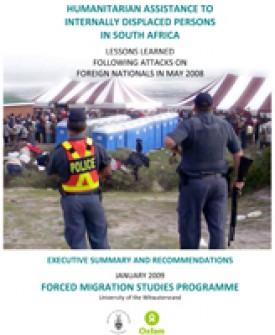Humanitarian Assistance to Internally Displaced Persons in South Africa
Resource type: Research Report
Forced Migration Studies Programme |
Civil society and government can learn key lessons from the humanitarian responses to the displacement of thousands of people in South Africa as a result of attacks against foreigners in 2008, according to this report by the University of the Witwatersrand, South Africa.
This report was produced by the Forced Migration Studies Programme at the University of the Witwatersrand, South Africa. The research for this report was conducted by Vicki Igglesden. The report was written by Tamlyn Monson (Chapters 1, 2 & 3), Vicki Igglesden (Chapter 4-9) and Tara Polzer (Chapter 10), with Tamlyn Monson and Tara Polzer providing overall editing. This report was commissioned by Oxfam GB in South Africa. All statements of fact and expressions of opinion in the report are the sole responsibility of the authors and do not necessarily reflect the views of Oxfam GB. Forced Migration Studies is a grantee of The Atlantic Philanthropies.
Executive Summary
This report documents civil society’s and government’s humanitarian responses to the displacement of thousands of people in South Africa as a result of widespread attacks against foreigners in May 2008. This was the first such internal displacement crisis since South Africa’s transition to democracy in 1994, and both governmental and civil society structures were ill-prepared to provide appropriate humanitarian assistance. The aim of evaluating these responses is to learn lessons for future disaster management and increase the effectiveness of future emergency responses.
In common with many other disasters, the initial humanitarian response was chaotic. There was consensus among agencies that the quality and speed of response must be improved should similar humanitarian disasters occur in the future. Without exception, agencies involved in the response identified lack of preparedness, coordination and communication as key determinants of the quality of humanitarian assistance provided.
It is likely that large-scale displacement, whether man-made or caused by natural disaster, will occur in South Africa again. It is therefore crucial that lessons are learned from this experience. Towards this aim, the Wits Forced Migration Studies Programme monitored humanitarian responses by government and civil society in Gauteng and the Western Cape – the provinces where the magnitude of displacement was the greatest – and this report evaluates these responses in relation to international best practice guidelines.
Some of the characteristics of the May 2008 disaster response are specific because most of the internally displaced persons (IDPs) were foreign nationals. However, many of the technical and organizational lessons apply to all humanitarian emergencies regardless of the population affected. Hence this report and its recommendations are written with the prospect in mind that South African citizens might well predominate amongst beneficiaries in future complex humanitarian disaster scenarios.
Given the likelihood of future displacement, it is concerning that much of the momentum and experience gained in the months following May already seems to have dissipated. It is encouraging that many institutions in government, civil society and the UN system have carried out evaluations of their own responses, some of which have been made public, and there have been some cross-sectoral ‘lessons learned’ exercises. However, many civil society organisations dropped out of the disaster response even before the displacement shelters were closed due to exhaustion and lack of funds, and many municipal and provincial governmental actors were similarly keen to ‘get back to their real work’ and leave the emergency mode behind. More importantly, the fledgling coordination structures which had developed within civil society and between government and civil society – including regular forums and information sharing websites – have collapsed, returning the sector to a similar state of fragmentation as before the disaster. In addition, rather than building mutual knowledge and trust, the often ad hoc interactions between disaster response actors in many ways led to an increase in frustration and suspicion between government and civil society, between civil society and the UN, within civil society, and within government (for example, between municipal, provincial and national actors). This lack of trust and communication needs to be overcome through regular structured interactions if future disaster responses are to be more effective.
This report, therefore, has three main aims:
- To provide a comprehensive record, as far as possible, of the disaster response by government and civil society actors, linking the experiences of many disparate organisations and integrating these experiences from the perspective of an overall disaster response ‘sector’, thereby identifying complimentary and clashing institutional roles, provision gaps, and coordination and communication needs;
- To act as a reference work, in tandem with existing humanitarian standards documents such as the Sphere Handbook,2 for South African disaster management practitioners on common problems to be avoided and factors to take into account in relation to material welfare provision, personal welfare provision, and protection as well as accountability, coordination and communication structures;
- To provide a basis for continued discussion among disaster response actors in government and civil society towards the development of robust communication and coordination processes and structures for disaster preparedness and response in South Africa.
With regard to all three aims, we hope therefore that this report will be used and engaged with as an active document by the following readers:
- Government officials from all spheres of the South African government,
- South African NGOs, CBOs, FBOs and individuals involved in the disaster response,
- INGOs working in South Africa,
- Private sector disaster management practitioners, and
- The media.
